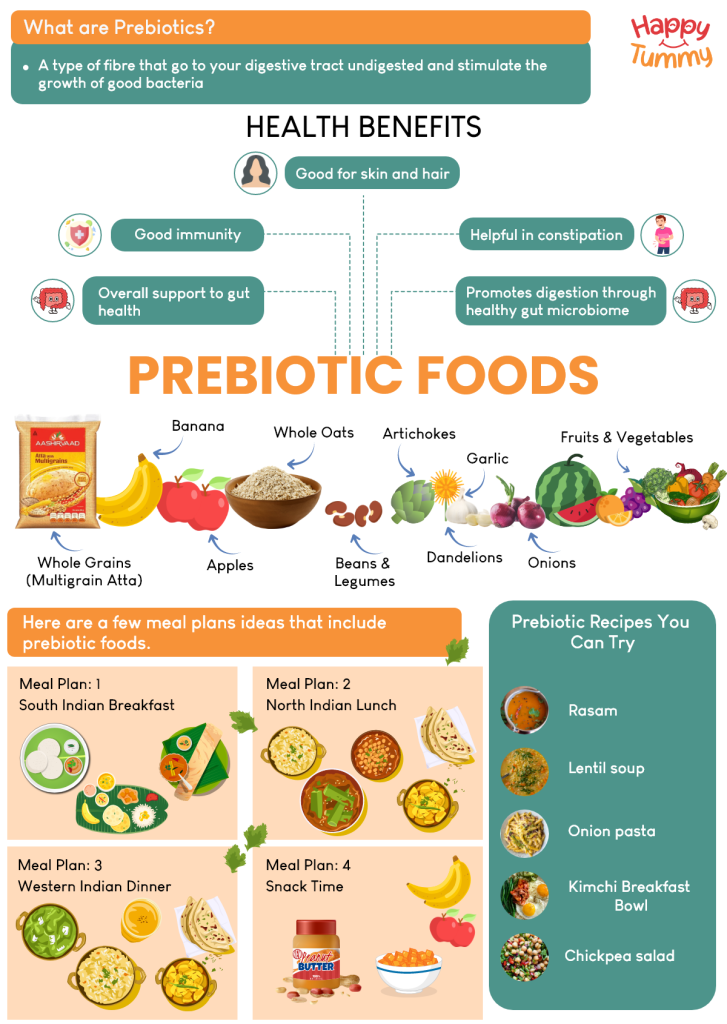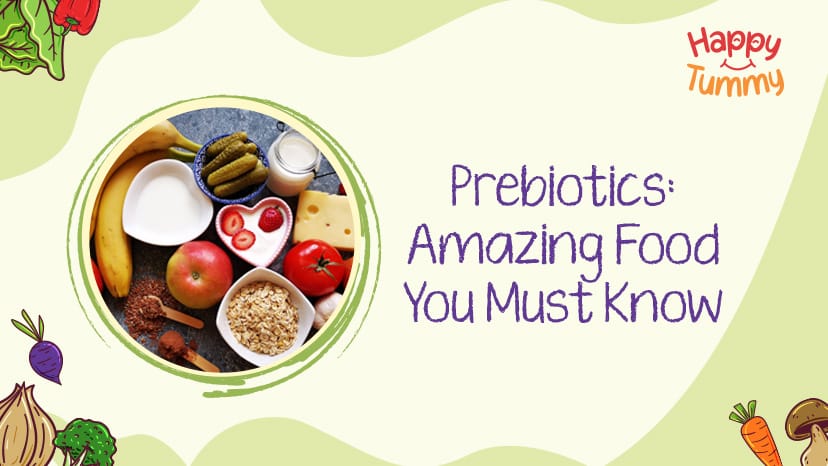Table of Contents
“My gut feeling tells me that prebiotic foods are the secret to a happy tummy, and I’m not just talking about the giggles.”
You might have heard a lot about prebiotic foods and all those fantastic facts and stories are true! Prebiotic foods are amazing for digestion and overall health.
They load the beneficial bacteria inside you, boosting your immune system, reducing inflammation, and improving digestion. Please read through the blog for complete information on prebiotic foods and how wonderful they are for you! It must prompt you to add them to your daily diet.
So, here we go.
What are Prebiotic Foods?

Prebiotic meals are a form of dietary fibre that your body cannot digest but your gut flora adores[1]. And as we know, a happy gut is the foundation of good health, which simply means that prebiotics are good for our overall health and digestion.
Gut bacteria need prebiotics as their food to flourish, as opposed to probiotics, which are live bacteria that you take directly. Dandelions, Garlic, onions, bananas, asparagus, and whole grains are excellent prebiotic food sources.
Whether you want to improve your digestion, strengthen your immune system, or reduce inflammation by taking healthy bacteria to feed in, prebiotic meals can be excellent companions!
Did You Know The Relationship between Fibre and Prebiotics? Prebiotics are a type of fibre, but all fibre foods are not prebiotics. Prebiotics are only those fibres that go to your digestive tract undigested and stimulate the growth of good bacteria in your large intestine.
It is further interesting to know that our bodies do not destroy prebiotics like a few probiotics, and heat also has less effect on prebiotics.
Still, there is no clear verdict on the impact of heat on prebiotics, so it is advisable to cook such foods less and only to the necessary extent[2]. For example, while you can prefer to eat bananas uncooked, oats and other grains need to be properly cooked to avoid stomach issues. So, eating judiciously is the key to fetching maximum benefits!
Prebiotics for Digestion
Fibre-rich prebiotic foods promote better digestion by feeding healthy gut bacteria. In order to have a good immune system, reduced inflammation and of course better digestion, a healthy gut microbiome plays a crucial role.
To understand it simply, consider that prebiotics helps ferment food faster, so they take less time in your digestive system. It helps in constipation and also results in better digestion.
Also, prebiotics helps you absorb calcium, keep the cells that line your gut healthy[3], and boost your metabolism. So, adding them to your diet is no less than a wise decision.
Prebiotics for Hair and Skincare
Put onions on your hair, yes you can!!! Also, you can add them to your diet with cloves of garlic; trust me it is less likely to stink!! It will balance the bacteria on your scalp, nourishing hair follicles to give your locks a radiant look!
Bananas contain high levels of antioxidants that protect the skin from damage caused by free radicals. These antioxidants can improve skin texture, reduce inflammation, and reduce the appearance of wrinkles and fine lines. Have you ever heard that rubbing a banana peel on your face gives your skin a fresh and glowing look?
YES, it happens, and prebiotics in bananas are one of the reasons for that!
Not only onion and bananas, but prebiotics are also suitable for keeping your hair and skin shiny and smooth[4].
From maintaining the pH balance to helping with acne and managing aging signs, prebiotics boost your skin and care, giving them the desired look. So, you can check for ingredients while shopping for hair and skin care products.
Easily Accessible Prebiotic Foods
Talk of Indian food, and fortunately, we have multiple options. We regularly use lentils, an excellent prebiotic source, in our diet. We use onion and garlic frequently in all vegetables; we use fermented foods like pickles and yogurt, and the list continues.
So, maintaining a diverse and healthy gut microbiota is easy if you know how to make variations in your diet.
Let’s have a look at some prebiotics that you will easily find in your kitchen!
- Beans and Legumes: kidney beans, soybeans, chickpeas, peanuts, and lentils etc are great to consume prebiotics. Apart from it they are the regular component of many Indian meals including rajma, chana masala, and dal.
- Onions and garlic: Onions and garlic are frequently used items in our homes. They enrich curries, chutneys, and biryanis with flavor and depth.
- Whole Grains: Brown rice, quinoa, and millet. And you know what?.. they are rich in prebiotic fibres. They are also a great source of vitamins and proteins.
- Vegetables: There are hundreds of sabzis available at your mandi- Dandelions, spinach, artichokes, and asparagus can be your pick. Your prebiotic intake can be increased by adding a variety of vegetables to your meals.
- Fruits: Apple, bananas, and kiwi are some excellent sources. They make a great variety of smoothies that can be eaten as a snack or dessert.
Quick Tips to Add Prebiotic Foods into Your Diet
- Kick-start your diet by adding some common foods everywhere; you need to look around and pick the right choice. You can cook with a generous amount of onion and garlic.
- You can season your dishes with onion and garlic powder. Look for brands that use fewer additives.
- Blend bananas into smoothies. Under ripe bananas are higher in prebiotics than ripe bananas.
- Add chia seeds and flax seeds to yogurt, smoothies, and oatmeal. Seeds are excellent sources of prebiotics.
- At times, satisfy your taste buds with dark chocolate. The higher percentage of cocoa in chocolates makes it more prebiotic. So, opting for a dark chocolate bar with 70 percent or more cocoa content can be your best bet!
- Eat all types of fruits and vegetables; they are your best mate. Apart from the high content of prebiotics, they are full of nutrition. Take a banana. Have you ever wondered why did the banana go to the doctor? Because it wasn’t peeling well! Jokes apart, make it a habit of consuming fruits and vegetables daily.
- Grains: Eat Whole grains like oats, quinoa, and brown rice. You can use Aashirvaad Atta with Multigrains which offers a wholesome goodness of six different grains: oats, maize, chana, soya, psyllium, and wheat.
- Fermented foods: yogurt, kefir, and kimchi are a few examples. Try adding fermented foods to your daily diet to maintain a good frequency of consuming prebiotics.
Let’s make Your Life Easy-Pizzy!
Here are a few meals plan[5] that includes prebiotic foods:
Meal Plan 1: South Indian Breakfast
Idli (made from fermented rice and lentils)
Sambar (made with tamarind, lentils, and vegetables)
Coconut chutney (made with grated coconut and spices)
Meal Plan 2: North Indian Lunch
Chana dal (made with split chickpeas, a great source of prebiotic fiber)
Brown rice (a whole grain high in prebiotic fiber)
Mixed vegetable curry (made with prebiotic-rich onions, garlic, and ginger)
Meal Plan 3: Western Indian Dinner
Rajma (kidney bean curry, high in prebiotic fiber)
Quinoa pulao (made with quinoa, a whole grain high in prebiotic fiber)
Raita (made with yogurt, a fermented food high in prebiotic fiber)
Meal Plan 4: Snack Time
Bananas (a great source of prebiotic fiber)
Carrot sticks (high in prebiotic fiber and other beneficial nutrients)
Peanut butter (a prebiotic-rich spread).
Not satisfied?? Want to make life a lot easier??
Try Aashirvaad My Meal Planner
Here are a few quick simple Indian recipes that feature prebiotic foods:
Recipe 1: Lentil Soup
1 cup red lentils, washed and drained
1 onion, chopped
2 garlic cloves, minced
1 tsp grated ginger
01 tsp cumin powder
1 tsp coriander powder
4 cups water
Salt, to taste
Instructions:
Use a non-stick skillet, heat the oil, and quickly stir-fry a combination of onion, garlic, and ginger until aromatic. Add the cumin and coriander powder. After simmering for 20 to 25 minutes, lentils are soft and tender. When the water and lentils are added, please bring it to a boil before reducing the heat. Blend the soup in a blender until it is creamy and smooth; just before serving, season with salt to taste. This lentil soup includes prebiotic-rich ingredients like onions, garlic, ginger, and also the lentils’ high prebiotic fibre content.
Recipe 2: Chickpea Salad
Ingredients: 1 bowl chickpeas, drained and rinsed; 1 small onion, chopped; 1 small tomato, chopped; 1 small cucumber, chopped; 1 tbsp olive oil; and 1 tbsp lemon juice.
Salt and pepper, to taste
Instructions:
Mix chickpeas, onion, tomato, and cucumber in a big bowl. Add a tablespoon of olive oil, lemon juice, salt, and pepper in a small bowl. Sprinkle this dressing over the salad and mix to blend. You are ready to eat the nutritious chickpea salad! The prebiotic fibre in this chickpea salad comes from the chickpeas and the onions and garlic in the dressing.
Wrap-up that Ties Together
If you want a healthy stomach, you must start now and why not with prebiotic meals? They can be your icebreaker. They hold so many benefits that you could never imagine.
The best part is that you need not make an extra effort to consume prebiotics. Just a little mindfulness and you can add them easily to your daily routine.
Many prebiotic foods are readily available and can be chipped into regular meals. Onions, garlic, asparagus, bananas, apples, chickpeas, lentils, oats, and whole grains like brown rice are just a few.
So, why wait? Now that you know their benefits, why more will it take to start eating them and fetch all benefits?
Frequently Asked Questions
Prebiotic food is the dietary fibre that provides you with good bacteria. These foods are critical for gut health because they offer a healthy balance of gut bacteria, improving immunity, easing digestion, and lowering inflammation.
In India, various foods such as onions, garlic, asparagus, bananas, apples, chickpeas, lentils, oats, and whole grains like brown rice are readily available. These are all excellent sources of prebiotic foods.
Well, anything, if it is excess, is harmful. Prebiotic meals may not have adverse effects. Still, overeating can cause bloating, diarrhoea, and other issues. You have to give time for a gut adjustment; start with a moderate quantity or small bowl of your favorite pick and then increase the diet gradually.
Prebiotic meals have been found to aid in weight loss by increasing feelings of fullness and lowering caloric intake. Furthermore, they improve gut health, which can benefit weight loss and metabolism.
Probiotics are supplements or foods that contain live microorganisms; their focus is to maintain or improve the “good” bacteria in the body. However, prebiotic foods are a form of dietary fibre that feeds good gut bacteria. Both foods can support a healthy gut flora balance and are essential for gut health.
Several prebiotic supplements are available, but it is always advisable to consult a medical expert before starting a new supplement regimen. More so, if you want to derive prebiotic fibre from natural products, you have several options, as mentioned in the article.















